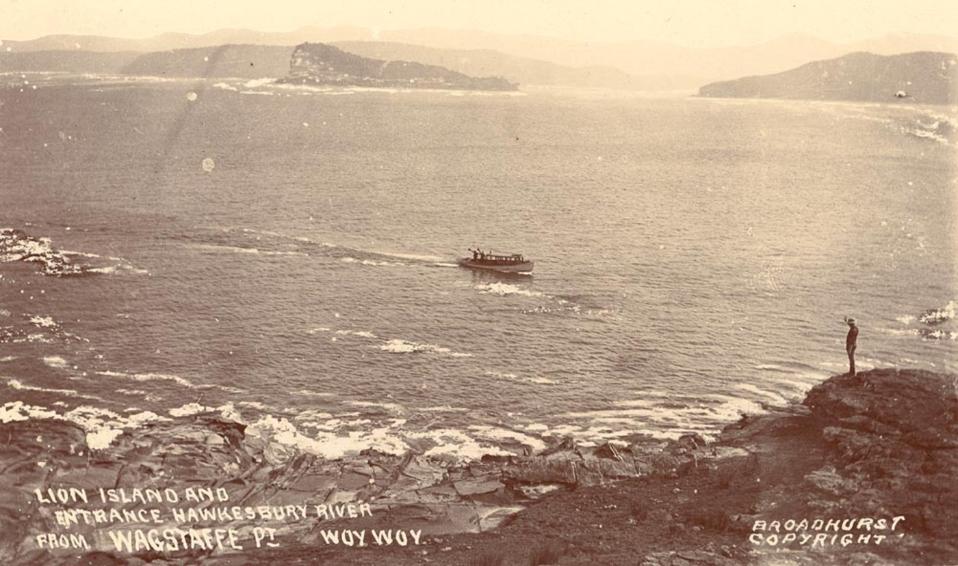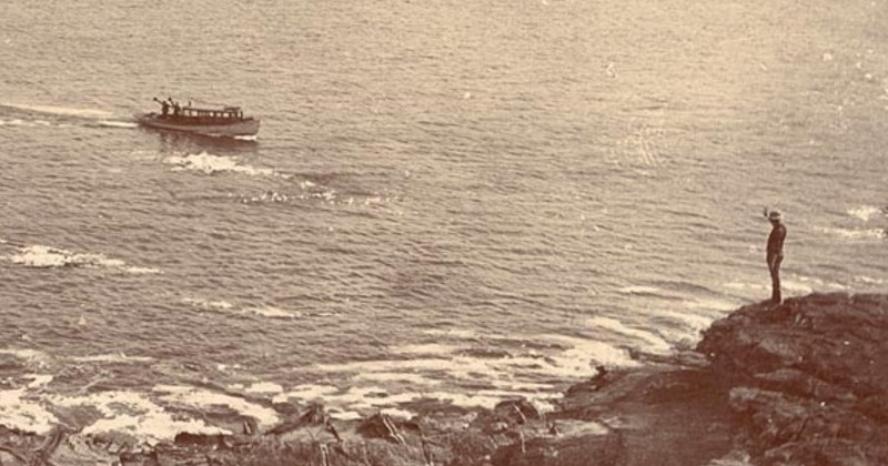March 24 - 30, 2019: Issue 398
The M.V. Reliance: 100th Year Celebration
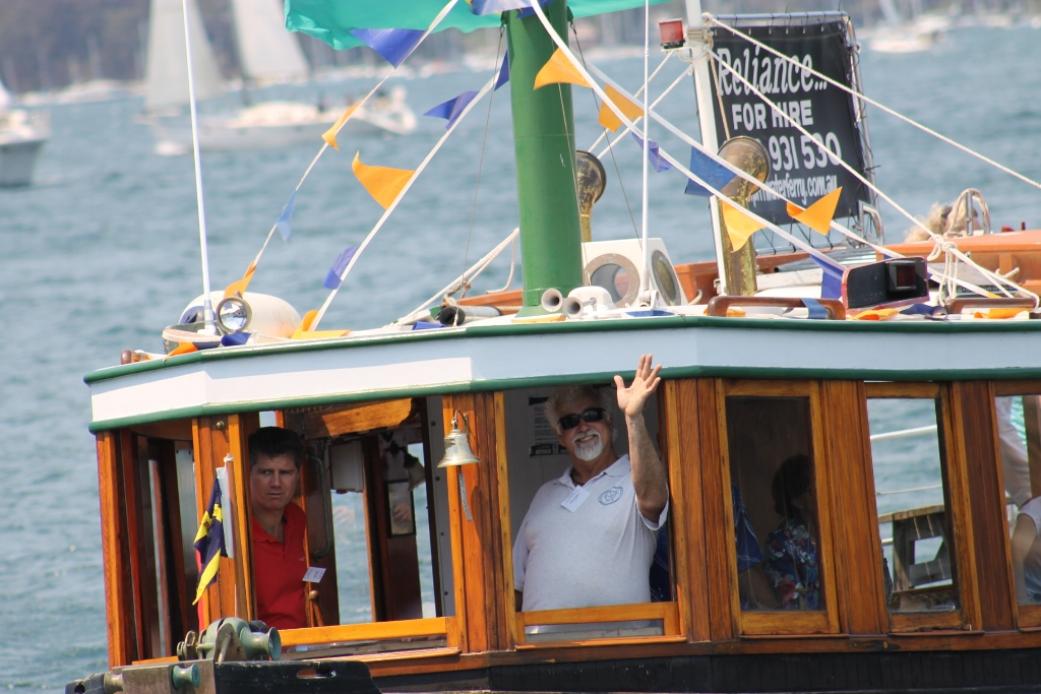
Mark Farrell and MV Reliance taking part in the RMYC of Newport's Open of Boating Season celebrations, 2012. AJG photo.
On Facebook: www.facebook.com/MV-Reliance
A grand old lady of Pittwater is celebrating her centenary in 2019 - the MV Reliance. Anytime there's anything happening on Pittwater - the Scotland Island Dog Race of a Christmas Eve, the Woody Point Yacht Club Gentleman's Launch and Putt Putt Regatta, the Careel Bay Marina Winter Festival or the Royal Motor Yacht Club's annual Wooden Boat Festival, which she will be a BIG part of again in this, her 100th year, or one off events like the Big Tow to raise funds for cancer research, Mark and Jools Farrell and the MV Reliance are there, ferrying people or being amongst the fun.
Mark bought MV Reliance 10 years ago. She had been at Lane Cove for 16 years prior to then, taking people out on Sydney Harbour.
When we asked Mark this week what the best thing about owning such an old classic is he replied;
"It's older than me and makes me feel young."
Why did you buy her?
"Possibly she's a having a mid-life crisis response".
MV Reliance is carvel planked with New Zealand Kauri and copper sheathed below the waterline.
The MV Reliance was built by Goddards of Palm Beach in 1919. William Joseph Goddard had purchased land in 1918 at the southern end of where the Golf Course is now shortly after his father, William Rueben Goddard, also a master boatbuilder, passed away in 1916.
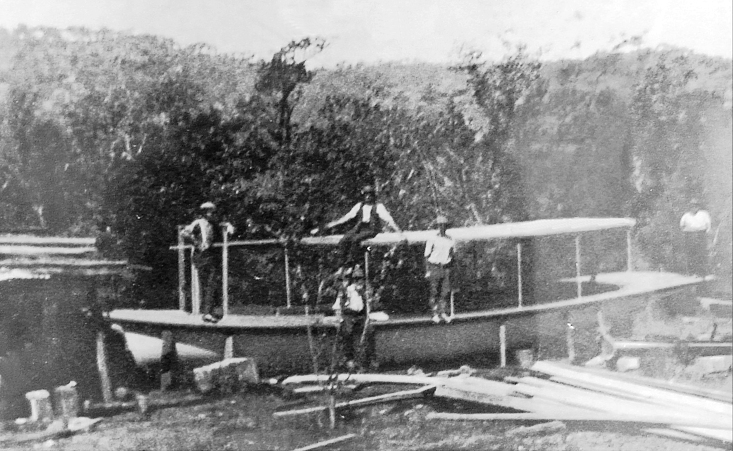
The Reliance at Goddards, Palm Beach, 1919
She was commissioned for the Hawkesbury River passenger and mail run from Brooklyn to Wisemans Ferry via Spencer.
Pauline Deas: The Reliance is looking fabulous now. My mother told me that when she was new, there were two mirrored pictures on the wheelhouse and toilet doors. One was an Arnott's Sao Biscuits mirror, the other Gargoyle Oil.
The ferry is credited with moving the first car to drive along the old track to Gosford over the Hawkesbury river on June 28th, 1925:
To a Buick Special Six belongs the honour of being the first car to be driven from Sydney, via Hornsby and Peat's Ferry (where the Hawkesbury River was crossed) to Gosford. The driver, Mr. A. W. Deas, reported on arrival in Gosford on Sunday night, that he had come through from Peat's Ferry to Gosford, via the old mail route, where no made road exists, without any mishap to the car, not even a puncture, though some difficulties were encountered on the way which were overcome with the aid of an axe and mattock. GOSFORD. (1925, July 1 - Wednesday). Newcastle Morning Herald and Miners' Advocate (NSW : 1876 - 1954), p. 3. Retrieved from http://nla.gov.au/nla.news-article137842978
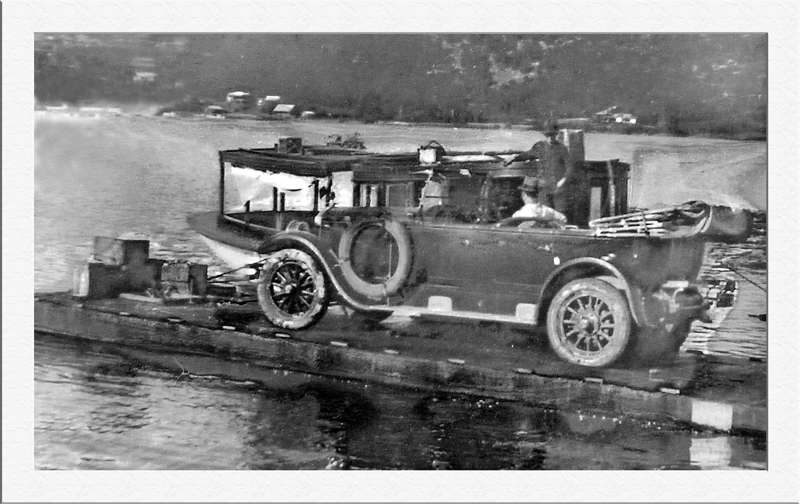
Reliance ferries the first car to drive to Gosford (a 1923 Buick) in 1923
A description of their drive:
Woy Woy Finds a Road
PRACTICAL ROUTE ROUND THE HILLS DISCOVERED.
'Woy Woy's isolation by road was ended on Saturday last, when Mr. V. J. McKenzie, of Gosford, drove his Buick Six, with the Shire President and Engineer, from Gosford to Woy Woy by a route along the western hills. The bridle track which had previously been used by Cr. Staples on horseback was found to lead through country the nature of which would permit of a trafficable road being made at comparatively little cost; and as at last Council meeting £250 was voted for the work from the Government endowment, to be supplemented by a like amount from the rates, it is hoped that it will not be long before it can be announced to the North, and to the State at large, that motor and other vehicles can come right into Woy Woy.
The approximate distances are:—
Miles
From Gosford via Main Road to Boys' Home 8
From Main Road along cleared road past Parry's 1 1/2
From cleared road over hills to Woy Woy Tunnel . . . . . 3 1/2
From Woy Woy Tunnel over hills to Dillon 's Gap at formed road 1
From top of hill down Dillon 's Eoad to bottom of hill .... 1
From bottom of hill to Woy Woy 1 1/2 .
'Pilot' writes: — When a Buick six-cylinder car, driven by Mr. V. J. MeKenzie, of Gosford, and carrying two passengers, Cr. C. J. Staples (Shire President) and Mr. C. J. Fenton (Shire ' Engineer) rolled into Woy Woy on Saturday afternoon, the locals could not for some time be convinced that this car had travelled under its own power and on its own four wheels from Gosford to Woy Woy. Yet this was the simple- truth. It was all the more surprising because of the fact that, as any Woy Woyan will tell you, the town is isolated so far as road communication is concerned, and even a horse-drawn vehicle has not yet negotiated the rough bridle track running from the Woy Woy Tunnel to the road near the Boys ; Home, about 3 miles from Gosford. The news soon got around and caused considerable excitement when Mr. McKenzie's accomplishment became known. Many were, at first, frankly sceptical, and those who were most inclined to doubt the truth of the report were those who know the track best — for they know from first-hand experience the difficulties of the mountain route.
It was known only to a few — and they had beforehand been sworn to secrecy — that the trip from Gosford to Woy Woy by motor car was to be attempted. And here it should be noted that the trip was undertaken without any preliminary examination of the route or any beforehand preparation of the track to be traversed. The 'overlanders' did not wish the attempt to be known for fear it might not be successful. When one particularly rough and apparently impassable natural obstruction was met with near the Woy Woy Tunnel, ''Mac. '' remarked, 'I hope no one has got wind of this stunt in Woy Woy!' And at this point the venturesome three feared that they would be classed as lunatics if they were to fail and the thing they had attempted became known. But. thanks to V.J. 's truly remarkable driving, the car was got through without mishap.
The Shire Councillors have recently' conducted a series of inspection by motor car all over the Shire, and on these trips 'Mac's' skill in negotiating rough and awkward country had shown that most road difficulties can be overcome by a daring and skilful driver. This prompted Cr. Staples to suggest to Mr. McKenzie that it might be possible for him to negotiate the bridle track over the mountains between the Boys' Home at Gosford and Woy Woy Tunnel. Always ready to tackle a difficult proposition, Mac. ' promptly promised ' ' to give it a fly.
It was at first thought advisable to go over the route on foot to make a preliminary examination of the route. But last Friday night it was decided to do the attempt the next morning by dispense with the usual preliminaries in a trip of this kind. So on Saturday morning a. start was made from the Gosford Railway ' The three miles by road to of the hill near the Boys' was speedily negotiated and the journey really commenced from this point, where a cleared track leads off to the south right on top of the hill.
For a mile and a half the going was good, as the road has been cleared for this distance, ending near Mr. Parry 's holding. From here it was found that the bridle track could not be negotiated by car on account of its many windings between rocks and up and down steep places. A route was chosen over the hills which necessitated much hard work in the way of clearing trees, grass-tree roots, and sometimes 'rock-chopping, as well as roughly forming steep activities and declivities, and filling in dry water-courses to allow the car to pass. The only accident of the trip was met with about a mile from the Woy Woy Tunnel, one of the rear mud-guards of the car being badly buckled through striking a fallen tree as the car swerved to avoid an obstruction just ahead. The telegraph line on top of the Woy Woy Tunnel was' reached at 12.30 — just three hours from the starting time. And, considering the roughness of the country, as well as the fact that at many points the car had to be left while the route ahead was surveyed on foot, this was making good time. At this point it began to be feared that the attempt would prove a failure.
After casting around for three hours to find a possible' ascent of the high hills on the southeastern side of the Tunnel a way out was eventually discovered. A little over a mile of exceedingly rough going. in which several sharp, steep climbs had to be made by the car. brought the party on to the formed road at the top of Dillon's Gap, leading from Woy Woy to Mr. George Dillon's. Here the party at last realised that the journey was practically accomplished, and that a few minutes later they would be the proud claimants o#' the distinction to be the first to enter Woy Woy from the outside by motor car. At a spring on the roadside the success of the trip vras drunk in good, clear water — the first*good water that was found during the journey, though the travellers had perforce to drink from many stagnant pools along the route. It may be mentioned that no food or drink was carried on the trip — certainly a great oversight! The road down from Dillon's to the railway line was found to be rough and steep, and its many awkward turns — it is only about 8ft wide with a precipice on one side — necessitated careful driving. But it was easy for 'Mac.' compared with the country he had been driving over all day, and the level land was gained without mishap. Three-quarters of a mile of sandy track brought the . car to the metalled road (Railway Street) near the Woy Woy South railway gates, and the car raced from here into Woy Woy with the 'hooter' in full blast. 'The arrival,' at 4.30 p.m., seven hours after leaving Gosford, was celebrated at Hadley 's with a bottle of champagne, the cork of which 'Mac.' annexed as a souvenir of the great occasion. Woy Woy Finds a Road (1923, March 15). The Gosford Times and Wyong District Advocate (NSW : 1906 - 1954), p. 6. Retrieved from http://nla.gov.au/nla.news-article166821685
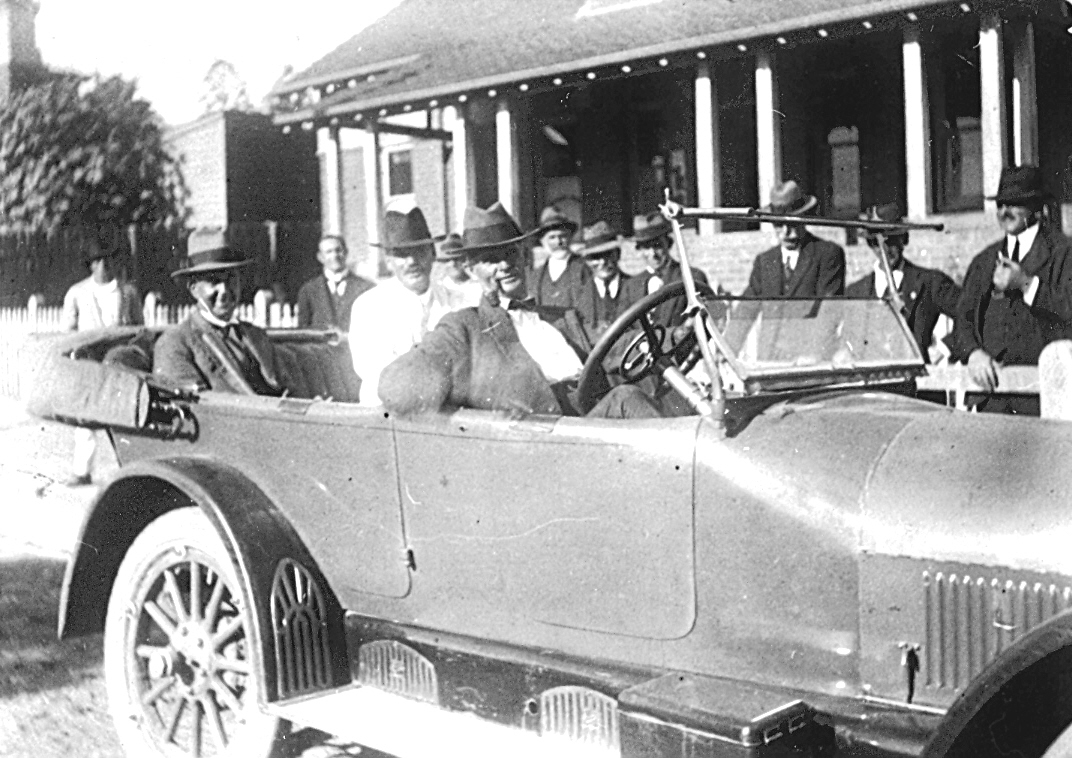
First car to drive to Woy Woy taken outside Erina Shire Council offices Mann Street Gosford March 1923. Photo courtesy Central Coast Library Service - Gostalgia .
The car was driven through bush by V.J. McKenzie of Gosford to prove that a road connecting Woy Woy to the outside world was possible. McKenzie was accompanied by Councillor C. J Staples (left) and Council Engineer C.J. Fenton (centre). The route they found was later to form the basis of Woy Woy Road. Photograph taken at Gosford outside the Erina Shire Chambers in Mann Street south. March, 1923. Brisbane Water Drive along the waterfront between West Gosford and Woy Woy was not built until the 1930s.
Another similar feat with connections to this old ferry:
Blazing the Trail
OVER PEAT'S FERRY ROAD 39 MILES IN TWO DAYS
A memorable trip over the old Peat's Ferry mail track, which is now strewn with boulders, overgrown with saplings, and in parts sunken in bogs and swamps, was made during the weekend by a party of three, the pioneers of the new direct route from Sydney to Newcastle. The speedometer registered 39 miles for the journey; but it took two days to do it, even though four miles of the registered 39 were skids. Once they were bogged to the running boards. Many times they had to cut down saplings to make a passage, or leave the car and break stones with the mawls they carried, to get the car through.
The party consisted of Messrs A. W. Deas and Fred Hawkins, of Windsor, and W. E. Phegan, of Gosford. The car was a special Buick Six, belonging to Mr. Deas, a member of the N.R.M.A., who was the driver. Leaving Kangaroo Point on Saturday morning, they drove to the Peat's Ferry crossing place. A pontoon was obtained from a boat shed, and Mr Deas' launch towed the car across.
CUT ROAD THROUGH SCRUB
For the first few miles on the other side they travelled with little difficulty, but their troubles began when they ran into thick scrub and rocks, and were faced with stiff ascents. Four miles from Peat's Ferry they saw no hope of getting further for the day, and struck camp. They had no provisions; so they spent what should have been the meal hour cutting scrub to make a track for the car in the morning, working with the aid of headlights. Early on Sunday they were off again, but several times the car was bogged. Mud was dug away, stones were laid as a foundation for the jacks, and the car was levered out each time. Once, all four wheels were down to the axels, and it took three hours to get out.
CAR JUMPS FOUR FEET.
They carried axes, picks and mattocks, and a maul for breaking stones, and all these tools were used at times to clear the track. Their next trouble was a series of swamps, but here the reeds made sufficient support for the car. Once the car hurdled a boulder, rose four feet from the ground, and landed at right angles to its course. Still they kept on.
On Sunday night they reached Gosford, tired and hungry, but triumphant. Gosford gave them a great reception, for the question of a new direct road to Newcastle has been an important subject in the district for years, and they were the first to get through on one of the alternative routes, which, it is estimated, will cut 60 miles off the distance between the two cities. Messrs Deas and Hawkins arrived in Windsor on Monday evening, and the car showed plainly of evidence of the rough trip. Blazing the Trail (1925, July 3). Windsor and Richmond Gazette (NSW : 1888 - 1954), p. 14. Retrieved from http://nla.gov.au/nla.news-article85897959
In the 1930's MV Reliance ferried workers building the road to Wisemans, to camps at Haycock mountain.
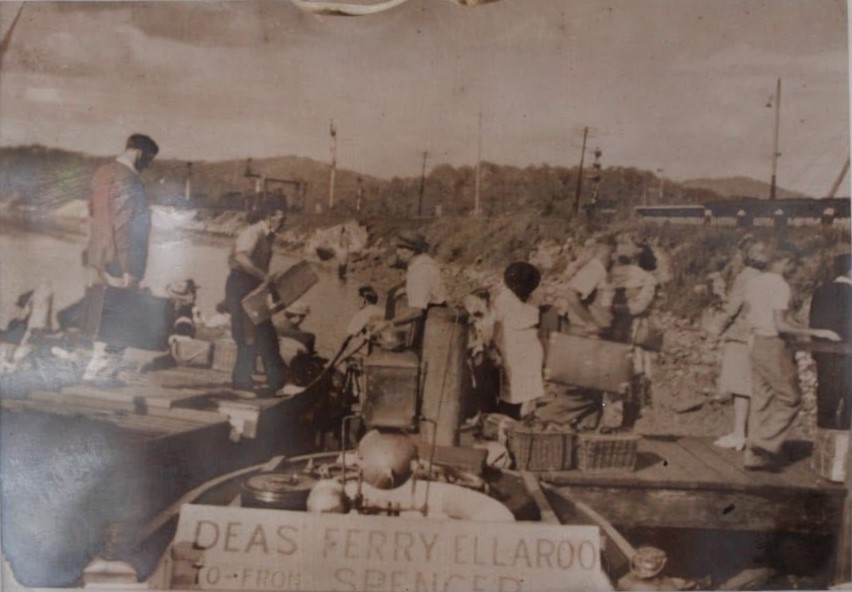
MV Reliance with the Dea's Ellaroo during the 1930's.
In 1942 the mail contract was lost to Les Smith of Kincumber. The Reliance was sold by Tony Deas to his brother, Vince Deas.
It was later purchased by Mr Tremain and taken to the Nepean, to be skippered by 'Count' Lance O'Meagher, as an excursion boat.
After WWll, when she was commandeered by the Army and a wheelhouse was added, she was brought back to the Hawkesbury by Vince Deas as a passenger and cargo boat.
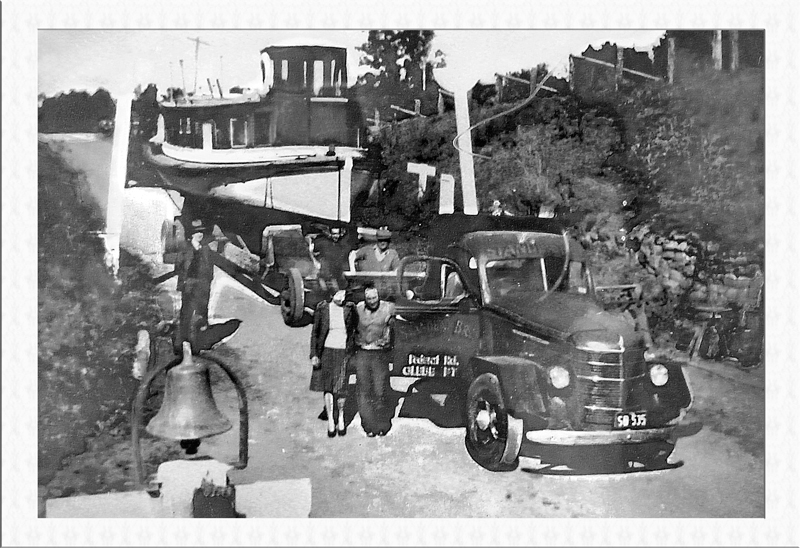
Reliance returns to Hawkesbury c1945
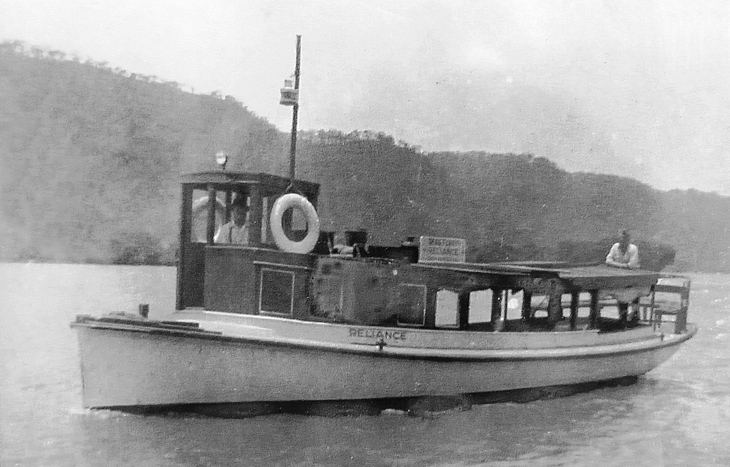
The Reliance with Wheelhouse added, 1945.
The Reliance was then sold to George Cook of Mangrove Creek. Mrs Cook continued The Reliance service after her husband's death until the old boat fell into disrepair. Reg Handy from Mooney Mooney went into partnership with Mrs Cook and repaired her. He used her as a passenger boat, carrying people from the Tropicana, Wilberforce for daily trips. She was vandalised while moored at Wilberforce and taken back to the Lower Hawkesbury, and sold by Mrs Cook for £3,000.
She was sold to the Outward Bound Movement. In 1972, the Outward Bound Movement was transferred and Holiday Camps of Australia purchased the property at Fisherman's Point and the boat.
MV Reliance then went to the Knox Grammar School.
The 'School Run'
Warwick Deacock, first Director of the Outward Bound School, (founded in 1941, to try to ensure the survival of young sailors in the North Sea), adopted Fisherman’s Point as the Australian home base from 1959 until 1973.
Knox Grammar purchased the property in 1973, for the boys to work towards The Duke of Edinburgh Award.
In 1977, members of the NSW Outward Bound ex-Students Association organised a canoe race along the river where they had trained. The 111km race raised money for medical research. The first race attracted 250 paddlers and raised $8,500. Now the race attracts more than 600 paddlers and raises annually in excess of $350,000.
The MV Reliance received a major refit and serviced Knox Camp on Fisherman's Point till 1995.
Note: Mark Farrell attended Knox from 1966 - 1978, OKG78.
The Harbour Run
Sold to the previous Guardian, Bill Moseley, MV Reliance moved to Sydney Harbour and spent 16 years on the Lane Cove River, taking passengers up to the weir and river park until 2009. While he had her Bill made a new tallow deck of 40mm by 22mm planks that had been coved out on the underside to resist warping.
Home to Pittwater and the Hawkesbury
In 2009 Mark Farrell purchased her and she came back to where she had been launched from.
Today she is available for hire, and has served as the perfect venue for weddings, birthdays or special events. She has capacity for 30 passengers plus 2 crew but numbers around 20+ allows ample room in all weather.
MV Reliance offers the classic style of the locally built 1920's estuary ferry with lots of varnished timber, comfortable seating and toilet washroom, open and spacious for entertaining, CD and iPod sound system, large iceboxes for drinks and a central table for food presentation. You can bring your own picnics or catering can be provided on request.
Based in Pittwater, but able to cruise the calm waters of the Hawkesbury River and Ku-ring-gai Chase National Park there are many options available for a special day out on Broken Bay.
With a shallow draft and stable easy access, she is able to access most wharfs on the many bays, beaches and private waterfronts in Pittwater, including the Basin, Newport, Palm Beach, Scotland Island, Bayview, McCarrs Creek and Church point.
In the Hawkesbury river, starting from Brooklyn, MV Reliance cruises downstream into Cowan creek; visiting Refuge bay and America bay, Cottage Point, Jerusalem bay and Smiths creeks to Bobbin Head all within the Ku-ring-gai Chase National Park.
Upstream from Brooklyn, the Hawkesbury river beckons and it is possible to reach locations such as Peats Bight, Spencer, Berowra and Wisemans Ferry in a day.
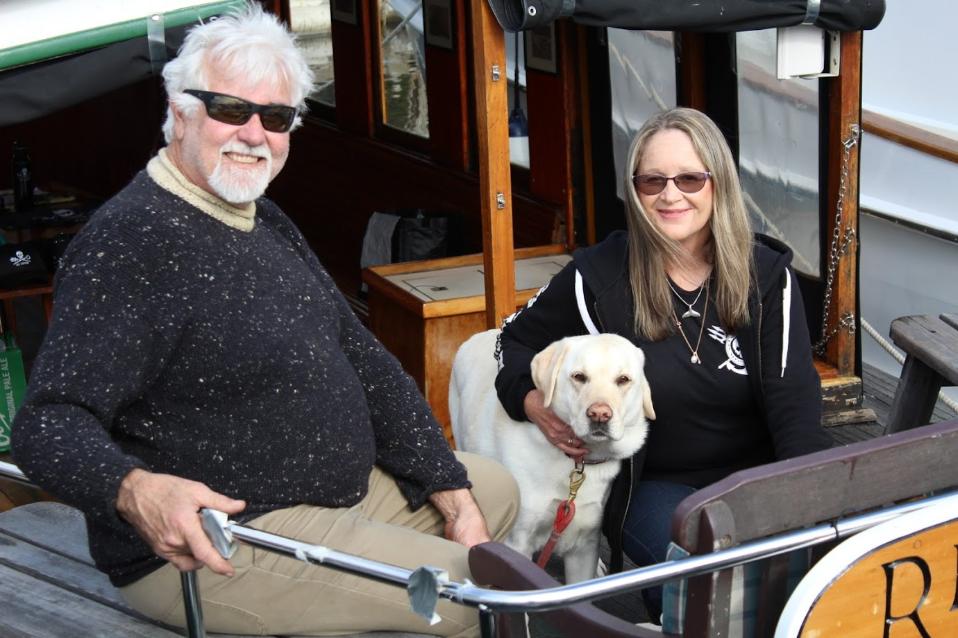
Mark, Tessa and Jools Farrell at Careel Bay Winter Festival 2016
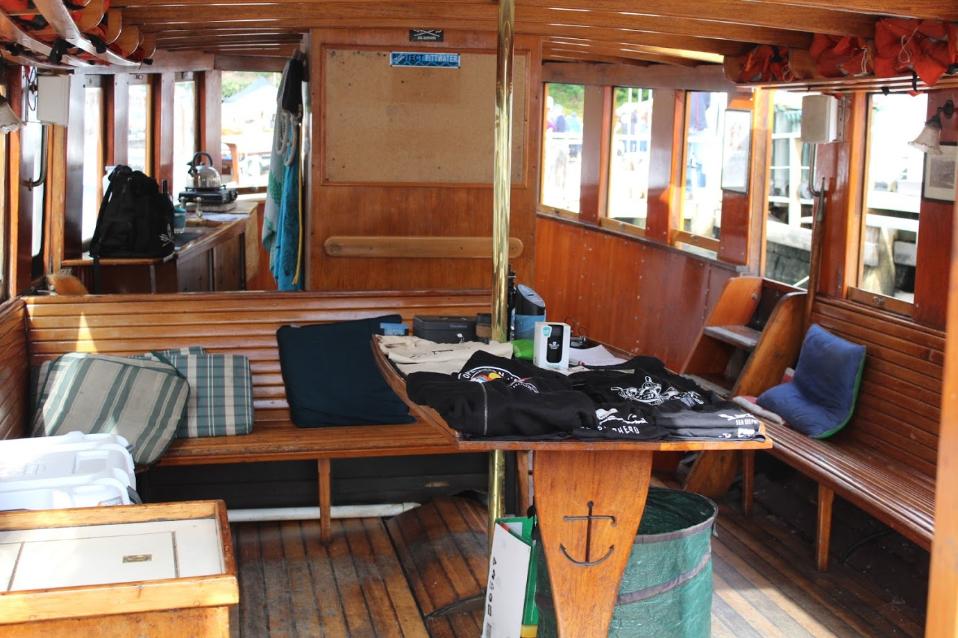
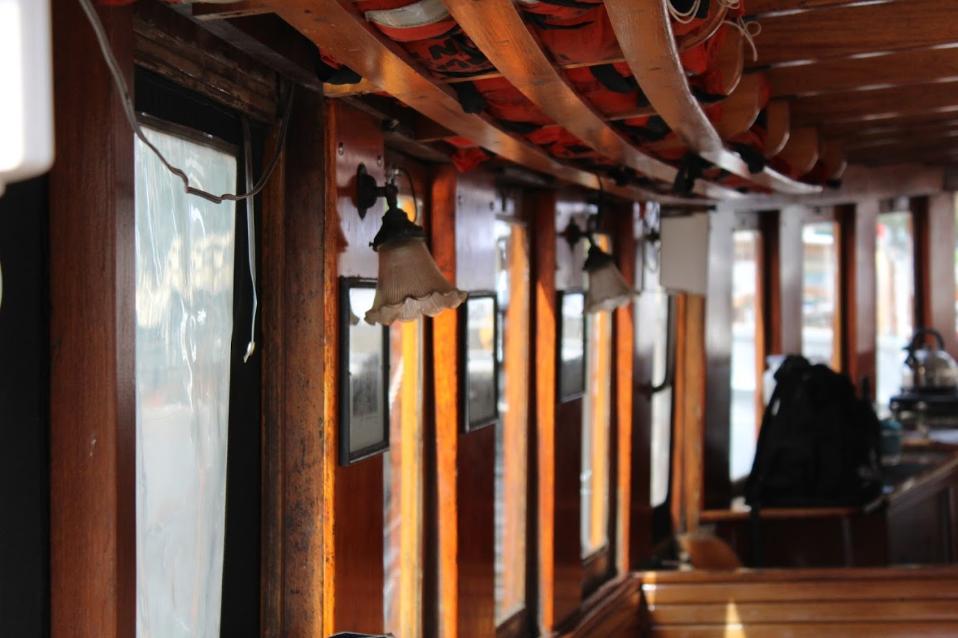
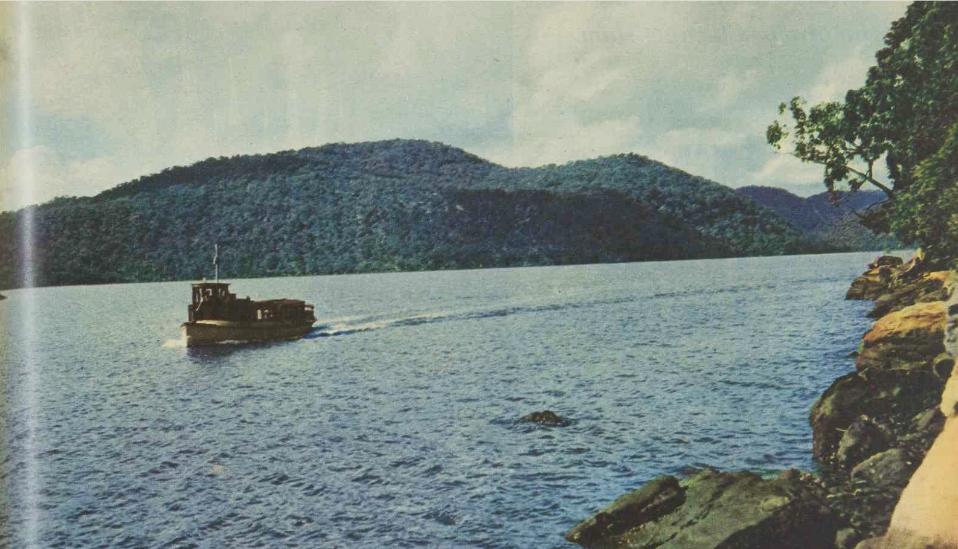
DOWAGER of the Hawkesbury River, the ferry M.V. Reliance, which has plied her daily way from Spencer to Brooklyn, to Spencer again, for more than 30 years, skippered by Emanuel Deas, of Spencer. River folk can set their clocks by her.
PENSION DAY ON THE RIVER (1961, May 24). The Australian Women's Weekly (1933 - 1982), p. 5. Retrieved from http://nla.gov.au/nla.news-article46939861
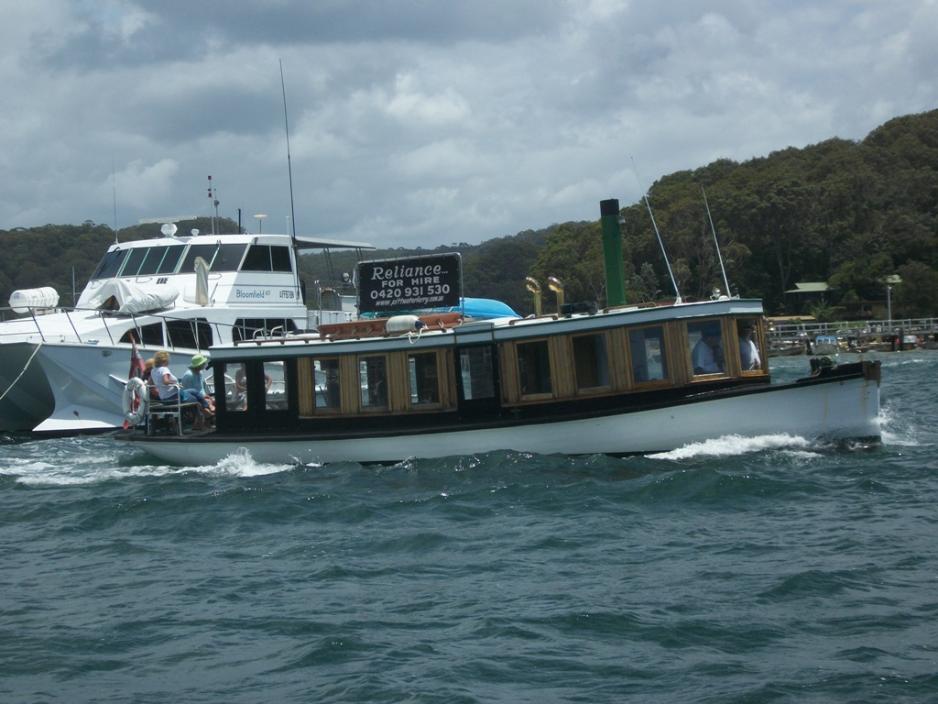
MV Reliance at Woody Point Putt Putt Regatta, 2012. Photo by A J Guesdon.
References And Extras
- Anne Howard. M V Reliance. Pittwater Online News, November 2012.
- TROVE - National Library of Australia.
- Mark and Jools Farrell.
- The Hawkesbury River Railway Bridge: Some Timely Winter Anniversaries And Commemorations For A Septuagenarian, Pittwater Online News, July 2018
- Moments In Time: A Book Of Australian Postcards - Pittwater Online News, July 2016; research for in page
Paddington.—Stolen, between 4.30 p.m. the 5th and 10 a.m. the 6th instant, from a motor launch moored at Elizabeth Bay wharf, the property of William Goddard, Palm Beach, Barrenjoey (city address, Vipond’s Boat Shed, Rushcutter’s Bay),—A Bosch magento, waterproof, N.: 1166305; value £10. Identifiable. Burglaries, etc. (1918, August 14). New South Wales Police Gazette and Weekly Record of Crime (Sydney : 1860 - 1930), p. 362. Retrieved from http://nla.gov.au/nla.news-article251745817
2. Brooklyn and Wiseman's Ferry, calling at Spencer Post Office Wharf, Courangra, Lower Hawkesbury and Laughtondale wharfs, on up and down trips, six times a week.—Joseph Izzard, Brooklyn, motor launch (15 horse-power), three years, £525 per annum. Conditionally. MAIL CONTRACTS NEW SOUTH WALES. (1919, February 13). Commonwealth of Australia Gazette (National : 1901 - 1973), p. 279. Retrieved from http://nla.gov.au/nla.news-article232510934
A HAWKESBURY RIVER SHARK.
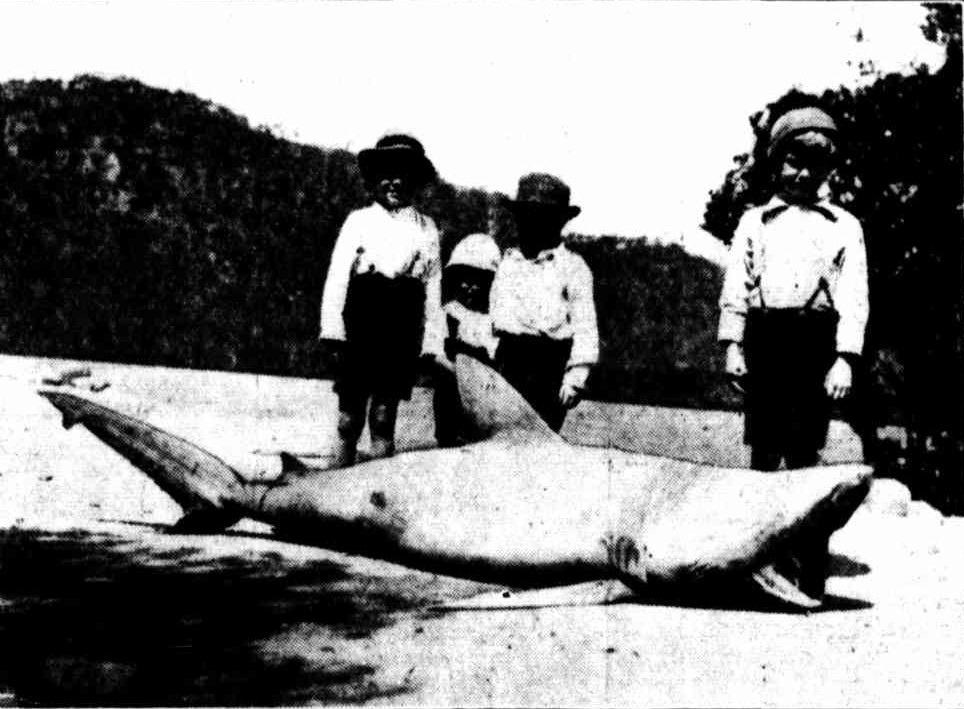
It was caught by V. Deas at Spencer, Hawkesbury River, and measured 8ft Gin in length. The photograph was sent to the 'Mail' by Kingsley Collier (aged 7-years). A HAWKESBURY RIVER SHARK. (1921, May 18). Sydney Mail (NSW : 1912 - 1938), p. 40. Retrieved from http://nla.gov.au/nla.news-article159039347booboo
ROBERT DEAS
A popular and much-liked native of the Mangrove River, Mr. Robert John Deas, passed away on Thursday of last week, at the age of 36. He died at his home, Mt. Colah, near Hornsby, suddenly, from heart failure. Bob Deas' untimely death is de-plored by a large circle of friends. He was a son of the late Anthony and Mrs. Deas, of Mangrove, and a brother of Mr. A. W. Deas, of Windsor and Brooklyn, and Mr. George Deas, of Gosford. Mr. A. W. Deas runs the service car from Windsor to Wiseman's Ferry, and has a line of motors running in Windsor. He also runs the mail launch from Brooklyn to Wiseman's Ferry and his brother George is the skipper. Deceased leaves a wife and two sons, and one daughter, whose respective ages are 11. 7 and 5 years. The remains were interred in the Catholic Cemetery at Mangrove. ROBERT DEAS (1925, May 29). Windsor and Richmond Gazette (NSW : 1888 - 1954), p. 3. Retrieved from http://nla.gov.au/nla.news-article85897083
BLAZING A TRAIL
Over Peat's Ferry Road
39 MILES IN TWO DAYS
A memorable trip over the old Peat's Ferry' mail track, which is now strewn with boulders, overgrown with saplings, and in parts sunken in bogs and swamps, was made during the week-end by a party of three residents of the Gosford district, the pioneers of the new direct route from Sydney to' Newcastle. The speedometer registered 39 miles for the journey but it took two days to do it, even though four mile of the registered 39 wore skids. Once they were bogged to the running boards. Many, times they had to cut down saplings to make a passage, or leave the car and break stones with the mawls they carried, to get the car through. The party consisted of Messrs. Deas, Hawkins and Phegan. The car was a special Buick Six, belonging to Mr. Deas, a member of the N.R.M.A., who was the driver. Leaving Kangaroo Point on Saturday morning, they drove to the Peat's ferry crossing place. A pontoon was obtained from a boatshed, and a launch towed the car across.
CUT ROAD THROUGH SCRUB
For the first few miles on the other side they travelled with little 'difficulty, but their' troubles began When they ran Into thick scrub and rocks, and were faced with stiff as-. cents. Four miles from Peat's ferry they saw no hone of getting further for tho day. and struck camp. They had no provisions; so they spent what should have been tho meal hour cutting scrub : to make a track for the car in the morning, working with the aid., of headlights. Early on Sunday they were off again, but several times the ear was bogged' . Mud was dug away, stones were laid as a foundation for the jacks, and car was levered out- each time. Once, all four wheels were down to the axles, and it -took three hours to get out.,
CAR JUMPS FOUR FEET
They carried axes, picks and , mattocks, -and a' maul for breaking stones, and all these tools were used at times to '.clear the track. Their next trouble was-, a series' of swamps, but here the reeds made sufficient support for the car. 'Once' the car' hurdled a boulder, rose four feet from the ground, and landed at right angles to its course. Still they kept on. On Sunday, night they reached Gosford, tired and hungry, but triumphant. Gosford gave them a great reception, for the question of a new direct road to Newcastle has been an important subject in the district for years, and they were the first to get through on one of the alternative routes, which it is estimated, will cut 60 miles off the distance between the two cities.
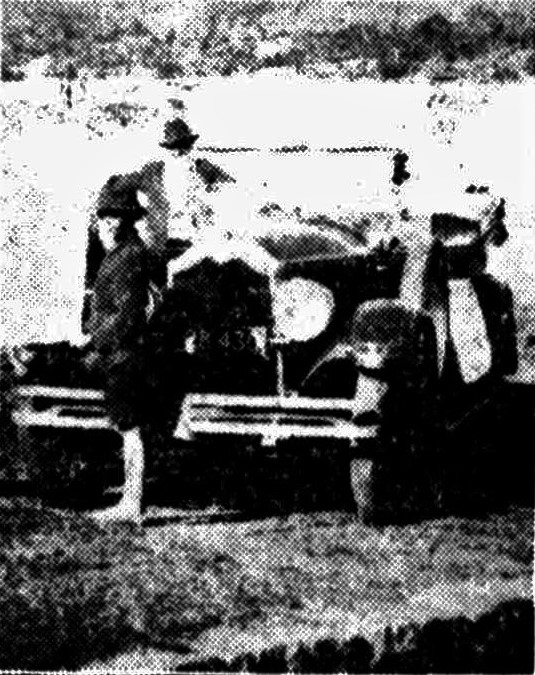
The car that did it just after landing at Peat's Ferry.
BLAZING A TRAIL (1925, June 29). The Sun (Sydney, NSW : 1910 - 1954), p. 9 (FINAL EXTRA). Retrieved from http://nla.gov.au/nla.news-article224044533
Woy Woy Finds a Road
PRACTICAL ROUTE ROUND THE HILLS DISCOVERED.
'Woy Woy's isolation by road was ended on Saturday last, when Mr. V. J. McKenzie, of Gosford, drove his Buick Six, with the Shire President and Engineer, from Gosford to Woy Woy by a route along the western hills. The bridle track which had previously been used by Cr. Staples on horseback was found to lead through country the nature of which would permit of a trafficable road being made at comparatively little cost; and as at last Council meeting £250 was voted for the work from the Government endowment, to be supplemented by a like amount from the rates, it is hoped that it will not be long before it can be announced to the North, and to the State at large, that motor and other vehicles can come right into Woy Woy.
The approximate distances are:—
Miles
From Gosford via Main Road to Boys' Home 8
From Main Road along cleared road past Parry's 1 1/2
From cleared road over hills to Woy Woy Tunnel . . . . . 3 1/2
From Woy Woy Tunnel over hills to Dillon 's Gap at formed road 1
From top of hill down Dillon 's Eoad to bottom of hill .... 1
From bottom of hill to Woy Woy 1 1/2 .
'Pilot' writes: — When a Buick six-cylinder car, driven by Mr. V. J. MeKenzie, of Gosford, and carrying two passengers, Cr. C. J. Staples (Shire President) and Mr. C. J. Fenton (Shire ' Engineer) rolled into Woy Woy on Saturday afternoon, the locals could not for some time be convinced that this car had travelled under its own power and on its own four wheels from Gosford to Woy Woy. Yet this was the simple- truth. It was all the more surprising because of the fact that, as any Woy Woyan will tell you, the town is isolated so far as road communication is concerned, and even a horse-drawn vehicle has not yet negotiated the rough bridle track running from the Woy Woy Tunnel to the road near the Boys ; Home, about 3 miles from Gosford. The news soon got around and caused considerable excitement when Mr. McKenzie's accomplishment became known. Many were, at first, frankly sceptical, and those who were most inclined to doubt the truth of the report were those who know the track best — for they know from first-hand experience the difficulties of the mountain route.
It was known only to a few — and they had beforehand been sworn to secrecy — that the trip from Gosford to Woy Woy by motor car was to be attempted. And here it should be noted that the trip was undertaken without any preliminary examination of the route or any beforehand preparation of the track to be traversed. The 'overlanders' did not wish the attempt to be known for fear it might not be successful. When one particularly rough and apparently impassable natural obstruction was met with near the Woy Woy Tunnel, ''Mac. '' remarked, 'I hope no one has got wind of this stunt in Woy Woy!' And at this point the venturesome three feared that they would be classed as lunatics if they were to fail and the thing they had attempted became known. But. thanks to V.J. 's truly remarkable driving, the car was got through without mishap.
The Shire Councillors have recently' conducted a series of inspection by motor car all over the Shire, and on these trips 'Mac's' skill in negotiating rough and awkward country had shown that most road difficulties can be overcome by a daring and skilful driver. This prompted Cr. Staples to suggest to Mr. McKenzie that it might be possible for him to negotiate the bridle track over the mountains between the Boys' Home at Gosford and Woy Woy Tunnel. Always ready to tackle a difficult proposition, Mac. ' promptly promised ' ' to give it a fly.
It was at first thought advisable to go over the route on foot to make a preliminary examination of the route. But last Friday night it was decided to do the attempt the next morning by dispense with the usual preliminaries in a trip of this kind. So on Saturday morning a. start was made from the Gosford Railway ' The three miles by road to of the hill near the Boys' was speedily negotiated and the journey really commenced from this point, where a cleared track leads off to the south right on top of the hill.
For a mile and a half the going was good, as the road has been cleared for this distance, ending near Mr. Parry 's holding. From here it was found that the bridle track could not be negotiated by car on account of its many windings between rocks and up and down steep places. A route was chosen over the hills which necessitated much hard work in the way of clearing trees, grass-tree roots, and sometimes 'rock-chopping, as well as roughly forming steep activities and declivities, and filling in dry water-courses to allow the -ar to pass. The only accident of the trip was met with about a mile from the Woy Woy Tunnel, one of the rear mud-guards of the car being badly buckled through striking a fallen tree as the car swerved to avoid an obstruction just ahead. The telegraph line on top of the Woy Woy Tunnel was' reached at 12.30 — just three hours from the starting time. And, considering the roughness of the country, as well as the fact that at many points the car had to be left while the route ahead was surveyed on foot, this was making good time. At this point it began to be feared that the attempt would prove a failure.
After casting around for three hours to find a possible' ascent of the high hills on the southeastern side of the Tunnel a way out was eventually discovered. A little over a mile of exceedingly rough going. in which several sharp, steep climbs had to be made by the car. brought the party on to the formed road at the top of Dillon's Gap, leading from Woy Woy to Mr. George Dillon's. Here the party at last realised that the journey was practically accomplished, and that a few minutes later they would be the proud claimants o#' the distinction to be the first to enter Woy Woy from the outside by motor car. At a spring on the roadside the success of the trip vras drunk in good, clear water — the first*good water that was found during the journey, though the travellers had perforce to drink from many stagnant pools along the route. It may be mentioned that no food or drink was carried on the trip — certainly a great oversight! The road down from Dillon's to the railway line was found to be rough and steep, and its many awkward turns — it is only about 8ft wide with a precipice on one side — necessitated careful driving. But it was easy for 'Mac.' compared with the country he had been driving over all day, and the level land was gained without mishap. Three-quarters of a mile of sandy track brought the . car to the metalled road (Railway Street) near the Woy Woy South railway gates, and the car raced from here into Woy Woy with the 'hooter' in full blast. 'The arrival,' at 4.30 p.m., seven hours after leaving Gosford, was celebrated at Hadley 's with a bottle of champagne, the cork of which 'Mac.' annexed as a souvenir of the great occasion. Woy Woy Finds a Road (1923, March 15). The Gosford Times and Wyong District Advocate (NSW : 1906 - 1954), p. 6. Retrieved from http://nla.gov.au/nla.news-article166821685
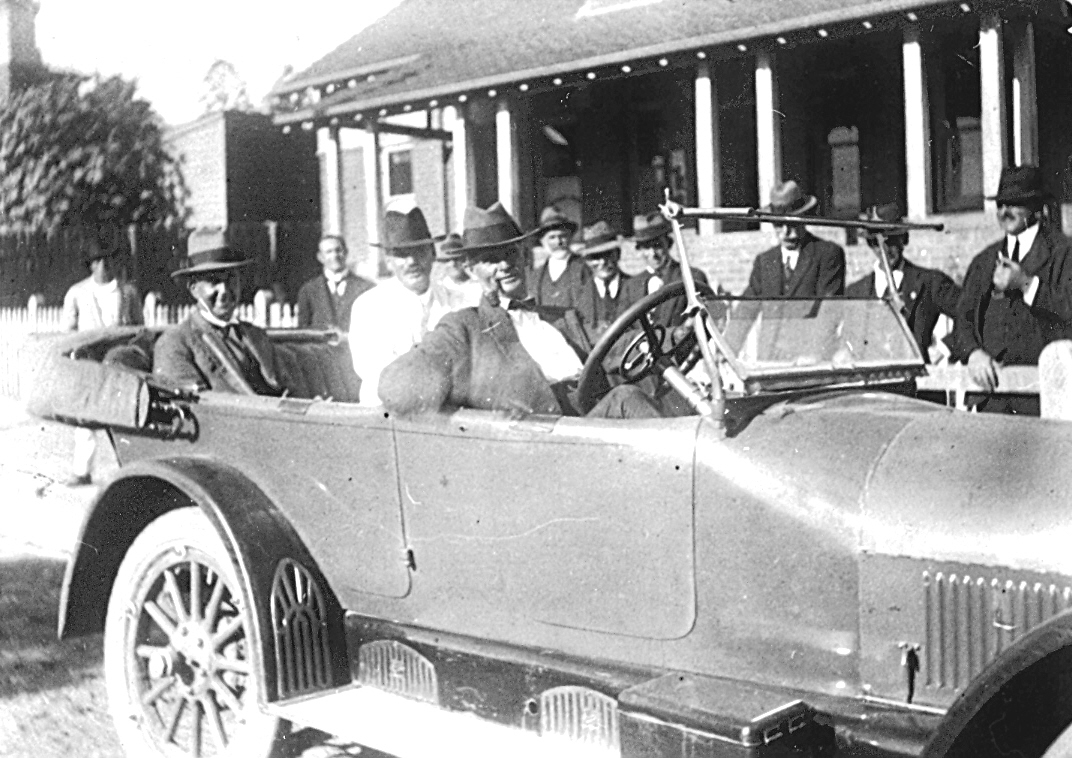
First car to drive to Woy Woy taken outside Erina Shire Council offices Mann Street Gosford March 1923. Photo courtesy Central Coast Library Service - Gostalgia .
The car was driven through bush by V.J. McKenzie of Gosford to prove that a road connecting Woy Woy to the outside world was possible. McKenzie was accompanied by Councillor C. J Staples (left) and Council Engineer C.J. Fenton (centre). The route they found was later to form the basis of Woy Woy Road. Photograph taken at Gosford outside the Erina Shire Chambers in Mann Street south. March, 1923. Brisbane Water Drive along the waterfront between West Gosford and Woy Woy was not built until the 1930s.
George Peat & His Ferry
Historic River Road
By J. A. Ferguson, B.A., L.L.B
In view of the controversy that has been taking place with regard to the re-conditioning of the old Peat's Ferry-road and making it the main road to the north, the following article by Mr. J. A. Ferguson, B.A., L.L.B., which was read before the Royal Australian Historical Society on April 28, 1925, should provide interesting reading. Next week we will publish another article, 'The OId Peat's Ferry- road,' by Mr. Frank Walker.
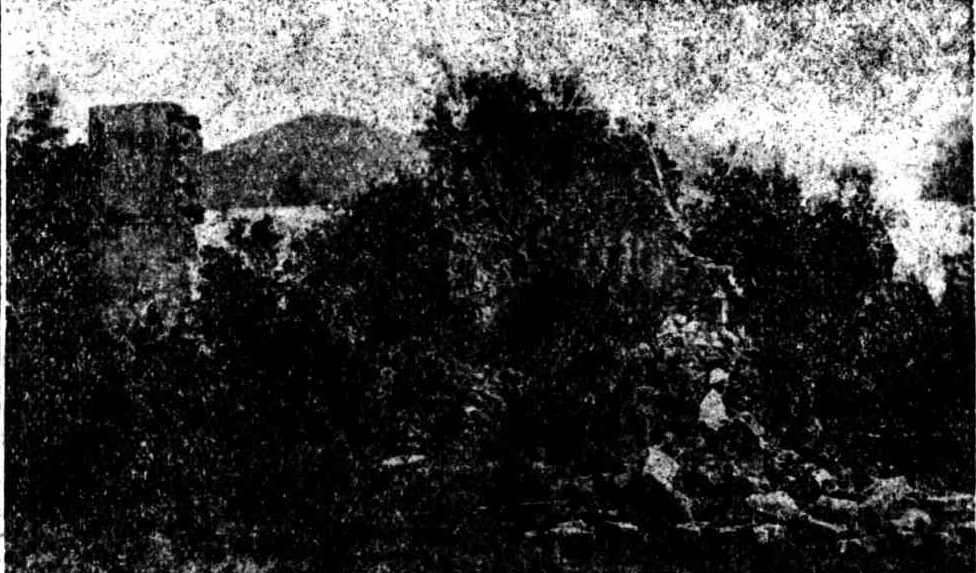
RUINS OF PEAT'S HOUSE, About 1880
The history of old Peat's Ferry-road inevitably carried the investigator back to a period antecedent to the existence of any formed road, or even the conception of such in any official mind. The creation of a road way, especially one requiring such difficult and costly construction through precipitous country, necessarily presupposes the existence of settlers with needs to be served by transport and travelling facilities.
The Hawkesbury River presented an insuperable barrier to the drover who desired to cross with his flocks and herds. How ever inconvenient and roundabout the way might be, he was compelled to proceed to the crossing at Wiseman's Ferry. This long journey to Sydney was troublesome to man and injurious to the condition of beasts being driven to the metropolitan markets. In the 'Australian,' July 19, 1836, a cor-respondent writes concerning the Wiseman's Ferry-road at that date: —
His Excellency's last trip to Maitland by water, and making his way to the Brisbane Waters, through a trackless bush, was the line of road intended by Sir Thomas Brisbane in his time. It may be regretted that His Excellency did not complete his route from Brisbane Waters to Sydney by the North Shore the latter might be reduced to a line of road not exceeding thirty miles. The inhabitants of the Brisbane Waters, at least the principal landholders, were induced to take up their grants from Sir Thomas Brisbane and late Mr. Oxley's pledge, that such a road was intended between Sydney and Newcastle. '
The latter dying, and the selfish Governor Darling falling in with an obliging Surveyor-General, they together concocted a road to their family estates, over by Wiseman's punt to the colonel's and captain's family bridges, and friendly estates, which cost this colony ninety thou-sand pounds — a road which few go over to Maitland or, Newcastle; or His Excellency, Governor Bourke would have taken a new route; and as to the inhabitants of Brisbane Waters, it is making the distance of thirty miles by land to Sydney better than one hundred and fifteen miles by the Wise-man's punt, over an impassable range on a trackless road, where neither dray nor beast can be driven over. Many thousands of cattle have been killed or lost in the fruit-less attempt of crossing the mountain, the best path of which only permits one beast to pass, and if turning round kills itself, and those in the rear; then the hundreds that have been drowned by the bad conditions of the punts. From this disappointment the town allotments are not worth looking after ..... and the principal land-holders of Brisbane Waters reside in Sydney ........ leaving that delightful lake a deserted village, inhabited by rum-drinking shingle-splitters, and I am sorry to say, murderers. . . . . The best fortune yet made in the district has been made from the sale of rum.
He points out that a direct road to Sydney would increase settlement, and so compensate for loss of passengers by increased shipments of produce, the writer knowing many "who would go fifty miles round to avoid the motion of any boat on the main ocean."
A contemporary pen picture of the deplorable state of the road from Sydney via Wiseman's Ferry is preserved in Lieutenant Breton's "Excursions in New South Wales, Western Australia and Van Dieman's Land' (London, 1834), p. 78.
After describing the journey from Parramatta to the bank of the Hawkesbury, he proceeds: —
The road on approaching the river is unfinished and in a very ruinous condition. At one spot, the side of it, built up with large stones, has entirely given away so as to leave a path only wide enough to admit of one vehicle, and of rather a dangerous kind. The river is two hundred and fifty yards in width, and thirteen fathoms in depth; and the distance from the sea is perhaps, forty miles in a direct line. The inn stands on a romantic and interesting spot, but there is far too little space between the Hawkesbury (and its branches) and the mountains to admit of much cultivation. We crossed over in a punt and immediately commenced the ascent of the Blue Mountains by a carriage road extremely creditable to the person who planned it. . . . . The scenery is mountainous to the Wollombi Brook, thirty-five miles, and there is not an inhabitant of any kind.
Although among these mountains there are some really fine views, much of the scenery is indescribably sombre. The eye seeks in vain for something more cheerful to look upon than a succession of ridges stretching as far as vision can reach, and deep gullies without a single spot uncover-ed by trees, and not a blade of grass in any direction. Yet there is a multitude of flowers, which contribute in some degree to adorn these solitudes; and they prove in a measure the truth of the remark that the poorer the soil the more it abounds in flowers.*
The problem of a more direct and convenient route to Sydney for the settlers of the Lower Hawkesbury and north-eastern areas had to be solved. George Peat solved it by the establishment of his famous ferry, thus, while benefiting himself directly, also proving himself a public benefactor. It is fitting therefore, that any account of the road itself should be prefaced by a biography, however incomplete or inadequate, of this sterling pioneer.
George Peat, the son of Charles Peat, was born in Sydney in the year 1792. At an early age he was apprenticed to the ship-building trade at the Government Dock-yards, Sydney. After completing his apprenticeship he made a brief visit to India. Returning to Sydney he commenced his trade as a shipbuilder, and resided in Kent street.
.jpg?timestamp=1553137089878)
GEORGE PEAT
.jpg?timestamp=1553137113827)
MRS. GEORGE PEAT
His first wife was Miss Blaxland, and the issue of this marriage, two sons; one died in infancy, but the elder, George, lived to the age of twenty-five years. He went to New Zealand, and it is stated was killed by the natives. His second wife was Miss Frances Ternen, and by her he had issue two sons and five daughters. One daughter Elizabeth, who was married to the late John Campbell, produce merchant, of Sussex-street, is still alive, aged eighty-five. To her perfect recollection I am indebted for many particulars in this sketch of her father.
The cause of George Peat's coming to the Hawkesbury was a desire to combine with the trade of a shipbuilder the business of a grazier. On January 4, 1836, fifty acres of land were granted to George Peat. This is described as situated at the head of a creek flowing into the Hawkesbury River at its confluence with Berowra Creek. A further grant was made to him on March 16, 1840, of sixty acres situated at Fairview Point, fronting the Hawkesbury River and Mooney Mooney Creek, opposite Spectacle Island, and is described in the grant as 'being the land promised to the said George Peat by Governor Darling.'
Though George Peat leased and owned other lands in the neighborhood from time to time, his total holding of freehold and leasehold lands at one time aggregating fifteen hundred acres, these two portions on opposite sides of the Hawkesbury constituted the substantial portions of his holdings.
Upon the northern area of sixty acres, situated at Fairview Point, he built his country house, described at the date of its erection, about the year 1840, as one of the best dwellings outside of Sydney. The view over the Hawkesbury from Fairview is unsurpassed. One writer, in an excess of enthusiasm, has written: —
Towards its mouth the Hawkesbury becomes romantic. This part of the river is to Australia what the Rhine is to Europe. It is the river of the artist and the tourist, and a favorite haunt of the yachtsmen. The great bridge of the Newcastle railway crosses it just about the point which divides the river proper from the estuary Bold cliffs rise three hundred feet from the water's edge, their faces of weather-worn sandstone displaying countless tints of red and brown; and great hills, timbered from base to summit, tower above, and are re-produced in the perfect mirror of water below. Reeds grow freely upon any bit of Swampy foreshore, and when a little patch of alluvial soil has been so far built up as to harden and become sweet, the corn grows tall and fair; and at evening or morning, or at any hour of a bright winter's day, there is beauty about the narrowing estuary which pen and pencil seek in vain to depict.
The beauty of form, the graceful lines of the, hills, the long water-tongue stretching out into the sea, the artist may depict, but who can paint the soft raiment of atmosphere — that finest of all textures woven by nature out of cloud and river mist, the soft, intangible film that beautifies all the crown and front of the mountain, and as a smile illuminates the human face — the violet lights, the purple shadows, the bands of emerald below and the shield of sapphire above, the river of gold that seems to roll out of the setting sun, and to flood all valleys and crown all hill-tops with every dying day.
The exact date of Peat's beginning his intermittent residence on the Hawkesbury is somewhat uncertain. In the New South Wales and Port Phillip General Post Office, Directory for 1839, published in Sydney by James Maclehose, at p. 126, George Peat is described as 'Settler, Hawkesbury River, Brisbane Water.'
This is the earliest reference to him which I have been able to find in any directory, and it is probable that his residence upon the Hawkesbury commenced between 1836-1839. At this stage we shall do well to banish from our minds the somewhat common conception of George Peat, as a man furnished with a boat, a windlass, and a rope, or per-haps with long oar or sweep, laboriously ferrying impatient travellers across the Hawkesbury, in much the same fashion as Charon ferried his patrons across the Styx. The true picture is of a vigorous and enterprising citizen having his town residence at 247 Kent-street and journeying at frequent intervals and staying for long periods upon his Hawkesbury lands. The ferry, while it was his private speculation, was operated by assigned servants or hired labor.
It is probable that Peat had his first location on the Kangaroo Point side of the Hawkesbury — a part now known as Peat's Bight, where huts were provided for his men and himself, but no residence was erected. At this stage water transport was not involved, but the acquisition of the Fairview Point area, in 1840, brought this question to the forefront. Peat found that if his squatting venture was to succeed he must find means of obtaining a quick and convenient access to the stock markets.
A track to Sydney, via Hornsby, or Pearce's Corner, he had no doubt devised while his activities were still confined to the southern bank. The water must now be crossed. He found other settlers further on towards Wyong and Wollombi, who would welcome a shorter track to Sydney, and who would be likely to avail themselves of any means of communication he might provide. No one could obtain a suitable boat more easily and cheaply than himself. He brings shipwrights or boatbuilders from his yards.
Suitable timber is felled upon, the banks of the river, and there the craft for Peat's Ferry is fashioned and launched. The exact crossing-place was no doubt dictated main-ly by the proximity of the opposing shores. Though apparently sheltered by Long Island, it was much exposed to westerly winds and affected by the full force of the tide. In a letter of Deputy-Surveyor-General Perry, dated February 10, 1850, and preserved in the Mitchell Library, we get a chance glimpse of this interesting vessel.
'The craft,' he writes, 'used for the transfer of horses and horned cattle is something of the description of 'Chasse Maree,' having sails, but worked by sweeps, and wholly unfit for the purpose intended.' The last words probably refer to the purpose intend-ed by the Deputy-Suveyor-General, and not to the original purpose in the year 1840, or thereabouts, of George Peat.
This passage incidentally confirms the view that the original purpose of the ferry was for the conveyance of his own and neighbors' stock to market. Mr. W. Lewis, in his reminiscences contributed to the 'Windsor and Richmond Gazette' (April 17, 1925) describes the punt running in 1852. He says:—
It was a two-masted boat, and was worked by a jolly old jack tar named Jefferson. He was a merry fellow, that Jefferson, and could spin a yarn or dance a lively step-dance with the next fellow. Crossing the Hawkesbury then was a rather slow process. One day I remember it took a whole day to get thirty-four horses across. On one occasion Mr. Osborne, who was taking a mob of horses from Maitland to Melbourne, reached the ferry, and while the horses were being carried across one of them sprang overboard and was drowned. My father salvaged the body and cut it up. The flesh was buried around the fruit trees in the orchard, but during the night the native dogs dug up the horseflesh and devoured it.
An official letter, dated January 24, 1854, states that the puntsman receives the punt dues in addition to £50 per annum from the Government. He needs to be a sea-faring man, as so large a punt requires skill. Webster's dictionary defines a 'Chasse Marie' as a French coasting lugger, a species of craft familiar to Perry during his travels in the Peninsula War. It is not within my province to deal with the history of Peat's Ferry-road.
I have undertaken merely to show how the made road came to be. It originated in the desire of squatters and settlers generally to find a quicker means of communication. George Peat as a pioneer settler connected the rough track to Sydney with the far bank of the Hawkesbury by his ferry. This connection caused a greater traffic of man and beast along this track via Peat's Ferry to Pearce's Corner, and induced the Government, about 1849, to turn its attention to the survey and construction of a proper road along Peat's line. Peat's skill as a path-finder is proved by the adoption of his line by the official surveyors.
In this connection some evidence given before the Select Committed on the Great Leading Thoroughfares of the Col-ony (December 9, 1851) is interesting. A witness (p 27) stated: —
In order to go by what I call the New Northern-road, you start from Milson's or Blue's Points to Aaron Pearce's; then from Aaron Pearce's it is about twenty miles on the right to Peat's Ferry on the Hawkesbury; and I understand from Mr Perry who superintended the making of the road that you could drive a coach and four along it. You can then proceed to Wollombi, Newcastle or Maitland, by a much shorter and more level road than the old Northern road.
He was asked: 'Suppose a Government surveyor were starting from Sydney to choose the best line for the Great Northern road, what course would be take?' His reply was: 'He should commence with the Lane Cove-road, and cross at Peat's Ferry.' Captain Perry said (p. 34) that the saving between the two roads; Sydney to Wollombi, was fifteen miles. He was further asked: 'You think this line the most eligible, for the Great Northern-road, especially as it would save eight miles in going to Peat's Ferry?' 'Yes, I never had any doubt that it was the most eligible line.' 'What is the distance across Peat's Ferry?' 'I reckon it about seven hundred yards; and this distance (as the river is affected by strong tides and currents) constitutes the only real difficulty on the line of road from St. Leonard's to Wollombi, but which will, in the course of time, be obviated by the application of steam as the propelling power to vessels crossing the. river.'
Mrs. Campbell, Peat's surviving daughter, tells of frequent journeys on horseback and by carriage along the road to and from the residence at Fairview Point. Residing in Kent-street, she attended school in Sydney. All long vacations were spent at Peat's Ferry. Open-house was kept for travellers passing along the lonely road.
On Sunday the Church of England clergy-man attended at George Peat's house and conducted a service, attended by the scattered settlers of the Lower Hawkesbury. Robert Lowe, afterwards Lord Sherbrooke, often spent a vacation here. Messrs. Hovenden, Hely, Osborne, Milson and E. H. Hargraves (the gold discoverer) were constant visitors on the way to their estates further north. Captain Wiseman, too, called frequently. Peat's photograph dis-closes a tall, dignified, well-set-up figure, clad in the correct broadcloth garb of the period.
Mrs. Peat, in turn, is revealed as an attractive lady, maintaining good looks; and happy appearance - in spite of the hardships of those rough pioneering days. The life at Peat's Ferry was, generally speaking lonely, the solitude broken only by infrequent visitors. Assistance was uncertain and remote in the event of trouble of any kind.
This continued, though perhaps in lesser degree, until the time of Peat's death. We find Mrs. Peat writing from Fairview Point to her daughter in Sydney, on June 21, 1864, as follows:—
'I daresay you have heard before this how ill your dear father has been, and still continues very helpless. I am sorry to say he is not able to stand. He seems so affected with weakness down his left side; and so resigned to the will of the Almighty in all he suffers. I hope and pray God he will soon be better? Let me know how you all are; it is the only pleasure I have, to hear from you all. I hope I shall be able soon to take your father to Sydney, though I think he would rather remain here. I often wish I was near some kind person, or some-one to stay a short time with me, as it is rather lonely for me.'
I quote this homely letter, as it is eloquent of the hardships and loneliness of settlers in this then distant outpost.
George Peat died at the residence of his son-in-law, W. C. Hayes, 103 Crown-street, Woolloomooloo, on August 9, 1870, at the age of seventy-eight, and was buried in Rookwood Cemetery. The dwelling at Fairview Point, was burnt down while vacant some time after his death.
To-day a few crumbling stones mark the spot, but fortunately a photograph of the building, while still retaining something of its original appearance, was taken after the fire. This discloses a two-storey house of respectable dimensions. The stones contained in the ruins were removed at a later date and used in the erection of a church upon an adjacent island in the river. To-day little else remains upon the old property at Fairview Point but the ruins of the house, an ancient and picturesque colonial oven, and the gravestone of Peat's daughter, Frances, with the following pathetic inscription, said to have been com-posed by herself, and neither better nor worse than most of such efforts: —
Sacred
to
the memory of Frances Peat
who departed this life March 23rd. A.D., 1843.
Aged 19 years and 9 months
Pray, dear parents, as you pass by;
Look on my grave, and do not cry;
But hope my soul has gone to rest
With my dear God,
Whom I love best
Part of the original estate still remains to the Peat relations, and this worthy pioneer's name is immortalised in the famous road and ferry.
The exposure of Peat's Ferry to fierce weather seems always to have operated to its prejudice. In 'The Gazetter of New South Wales' (Sydney; Sheriff and Downing), undated, but published about 1870, Peat's Ferry is described on Page 84 as —
The lower ferry of the Hawkesbury River crossed on the route from North Sydney to Gosford. It is wider and less safe than Wiseman's Ferry. The route then over-land to Wollombi has long been disused.
For some years the upkeep of the road seems to have been neglected and a final blow to the ferry was struck by the opening of the Hawkesbury Railway Bridge. This bridge is the largest of its kind in the Southern Hemisphere, and, as regards its foundations, one of the most remarkable in the world. The bridge across the Hawkesbury River is at a point thirty-six miles north of Sydney, ten miles from the sea, and about two miles from Peat's Ferry.
The successful tenderers for the work, which included the design, were the Union Bridge Company of New York, and they commenced operations about October, 1886. The design showed seven spans of four hundred and sixteen feet from centre to centre of the piers, built upon novel caissons. The last of the foundation caissons, which was launch-ed on May 9, 1887, and bottomed on May 11, 1888, was one hundred and sixty-two feet deep, being the deepest bridge foundation in the world at that date.
The roadway was completed on April 23, 1889, and the bridge was tested on April 24, by two trains, making up a total weight of nine hundred and ten tons. The bridge was formally opened for traffic on May 1. 1889. It is within the realm of possibility that a traffic bridge will one day span the old crossing-place at Peat's Ferry, and enable motorists to proceed direct to Newcastle and Maitland along a road unsurpassed for scenic effects.
(My cordial acknowledgements are due to Mr. Henry Selkirk, F.R.A.H.S., for valued assistance in the course of this investigation).
*See, also, Dr. Lang's experiences on the Wiseman's Ferry-road, as related in his 'Historical and Statistical Account of New South Wales,' 2nd Edition, vol. 2, pp. 75 et seq. (London. 1837).
The sad announcement of Mrs. Campbell's death 7/8/'25 reached the author as the proof of this article was being corrected.
George Peat & His Ferry (1925, October 23). Windsor and Richmond Gazette (NSW : 1888 - 1954), p. 2. Retrieved from http://nla.gov.au/nla.news-article85902992
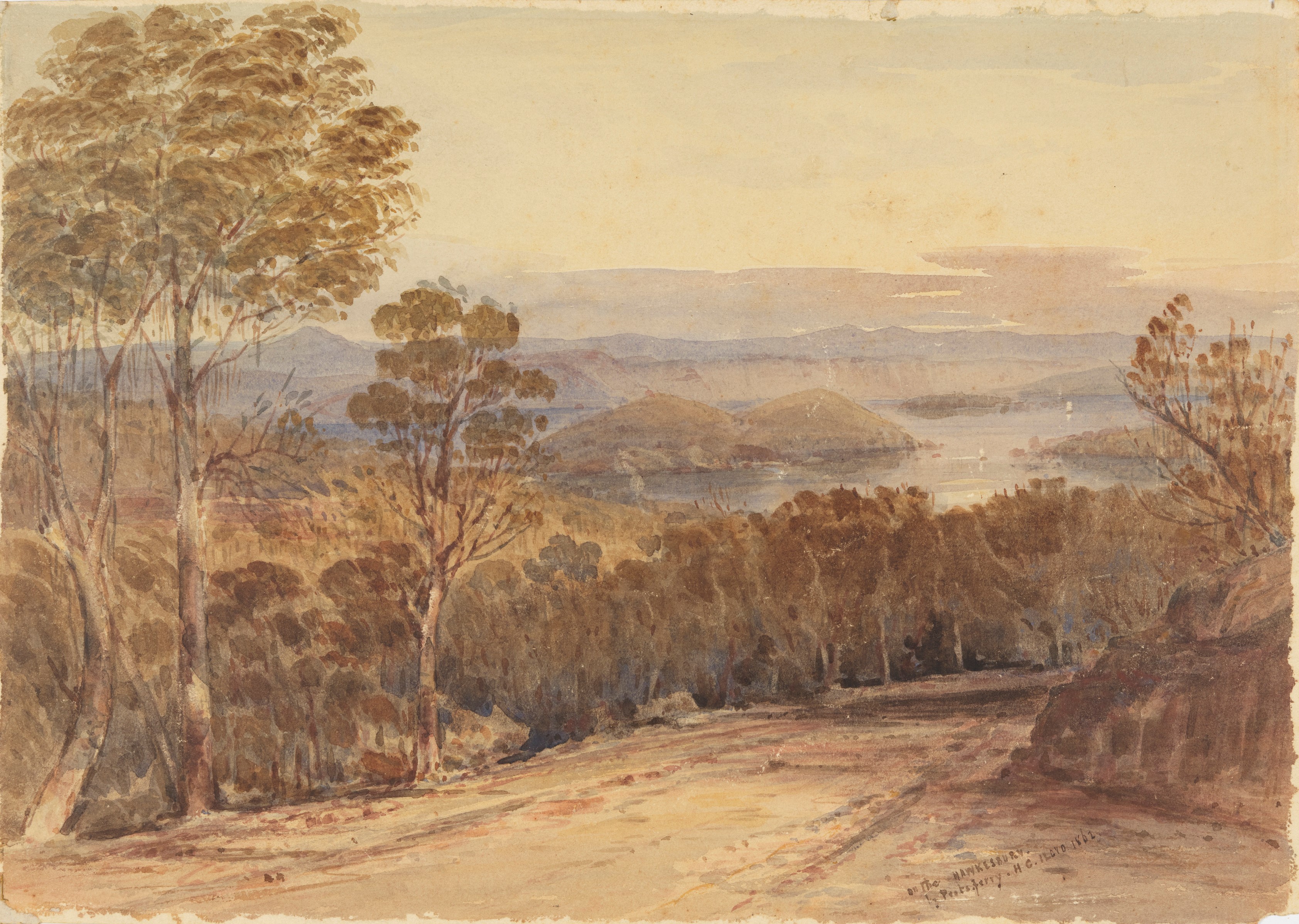
View on the Hawkesbury by Peats Ferry, 1862 by Henry Grant Lloyd. Item No.: c073200001, courtesy Dixson Library, State Library of New South Wales
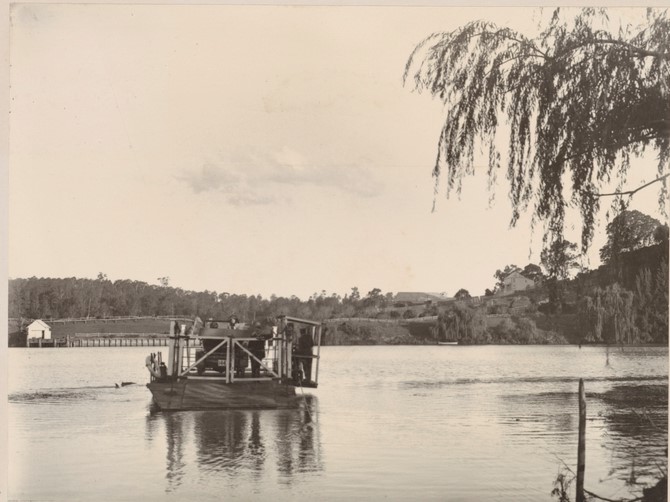
Easter Sunday, 7th April 1912- writing reads 'Today I took Ethel Maxwell and Primrose to see the Hawkesbury River near Windsor. Hastings, Margaret, Pat, Kelly and Joyce came too. We had the Fiat and Itala cars. This shows one of the cars crossing the Sackville Reach in the punt.' From Album 59: Photographs of the Allen family, 11 February 1912 - 15 June 1912. Image No.: a2877031h, courtesy Mitchell Library, State Library of New South Wales
